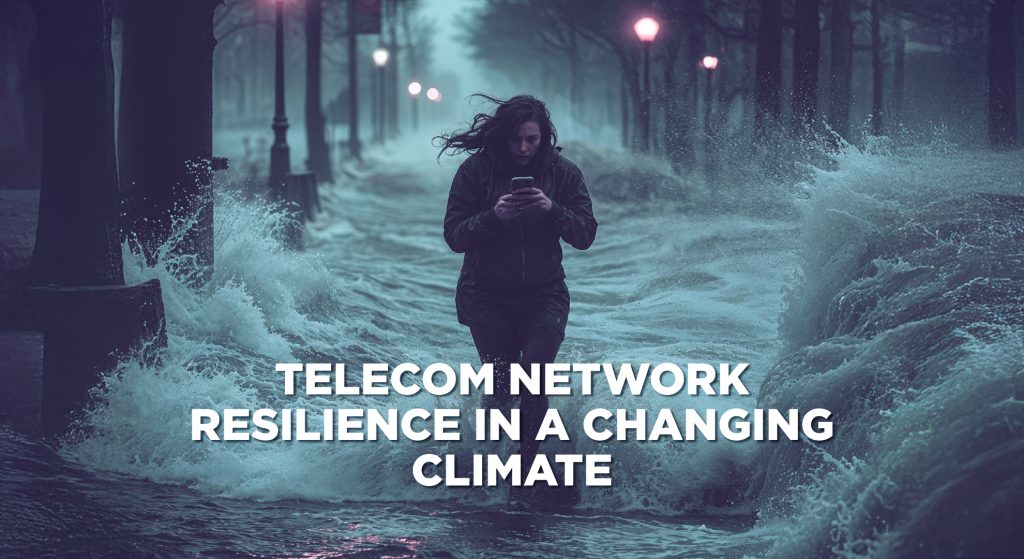The global effects of climate change, felt across continents, continue to challenge various sectors, including telecommunications. Extreme weather events, such as Hurricanes Helene and Milton, have highlighted the urgent need for telecom networks that can withstand severe conditions. However, climate change challenges extend beyond hurricanes, affecting telecom networks worldwide.
Global Impacts of Climate Change on Telecom Networks
The impacts of climate change on telecommunications infrastructure are as diverse as they are disruptive:
Melting Arctic Ice: Accelerated Arctic ice melt is intensifying erosion and causing permafrost thaw, threatening underground cables and tower stability. A 2019 study observed a 20% rise in permafrost thaw, putting telecom infrastructure in northern regions at greater risk.
Extreme Heat Waves: Prolonged heat waves can lead to equipment overheating, which disrupts network functionality and affects service reliability.
Wildfires: Climate-fueled wildfires can inflict severe damage on telecom infrastructure, causing prolonged service outages.
Flooding and Water Damage: With increased rainfall, the risk of data center and facility flooding has risen, posing a severe threat to critical network operations.
The Impact of Hurricanes Milton and Helene on Telecom Networks
The hurricanes that struck the U.S. in 2024, Helene and Milton, caused widespread devastation to telecom infrastructure. Their impacts included:
Physical Infrastructure Damage: Cell towers, fiber optic cables, and other network components were heavily impacted by high winds, flooding, and intense rainfall.
Power Outages: The hurricanes triggered extensive power outages, affecting base stations and switching centers.
Supply Chain Disruptions: The delay of essential equipment and repair supplies slowed network restoration efforts.
Telecom Network Resilience Strategies
To withstand and recover from such events, telecom operators have adopted a variety of resilience measures:
Redundancy and Diversification
Redundant Systems: Backup power generators and additional network equipment can help maintain services during failures.
Diverse Routing: By routing traffic through alternative pathways, operators can minimize the impact of localized disruptions.
Robust Telecom Network Management Systems

The Impact of Hurricanes Milton and Helene on Telecom Networks
The hurricanes that struck the U.S. in 2024, Helene and Milton, caused widespread devastation to telecom infrastructure. Their impacts included:
Physical Infrastructure Damage: Cell towers, fiber optic cables, and other network components were heavily impacted by high winds, flooding, and intense rainfall.
Power Outages: The hurricanes triggered extensive power outages, affecting base stations and switching centers.
Supply Chain Disruptions: The delay of essential equipment and repair supplies slowed network restoration efforts.
Telecom Network Resilience Strategies
To withstand and recover from such events, telecom operators have adopted a variety of resilience measures:
Redundancy and Diversification
Redundant Systems: Backup power generators and additional network equipment can help maintain services during failures.
Diverse Routing: By routing traffic through alternative pathways, operators can minimize the impact of localized disruptions.
Robust Telecom Network Management Systems

Real-time Monitoring: Systems such as SON solutions allow for real-time performance monitoring and management, enabling operators to address issues quickly.
Automated Fault Detection and Isolation: Automated network optimization systems help identify and isolate network faults, accelerating restoration.
Proactive Maintenance: Predictive analytics helps forecast potential problems, allowing preemptive maintenance to reduce downtime.
Emergency Response Planning
Pre-Disaster Planning: Comprehensive plans for response and recovery are crucial.
Rapid Team Deployment: Quickly deploying skilled teams ensures faster assessment and repair.
Effective Communication: Clear communication channels with local authorities and emergency services streamline efforts and keep customers informed.
Post-Disaster Recovery: A solid recovery strategy is essential for restoring service and addressing long-term needs.

Telecom Network Resilience Strategies During Hurricanes Milton and Helene
During Hurricanes Milton and Helene, telecom operators demonstrated resilience through a variety of strategies:
Rapid Deployment of Mobile Cell Sites: Mobile cell sites provided temporary coverage where infrastructure was damaged.
Backup Power Sources: Backup generators kept networks operational amid widespread outages.
Coordination with Authorities: Close collaboration with local officials enabled quick access to affected sites and facilitated repairs.
Innovative Solutions: Using drones for inspections and repairs helped operators navigate logistical challenges.

Telecom Network Resilience Strategies During Hurricanes Milton and Helene
During Hurricanes Milton and Helene, telecom operators demonstrated resilience through a variety of strategies:
Rapid Deployment of Mobile Cell Sites: Mobile cell sites provided temporary coverage where infrastructure was damaged..
Backup Power Sources: Backup generators kept networks operational amid widespread outages.
Coordination with Authorities: Close collaboration with local officials enabled quick access to affected sites and facilitated repairs.
Innovative Solutions: Using drones for inspections and repairs helped operators navigate logistical challenges.
Lessons from Hurricane Milton and Helen
Hurricanes underscored critical insights for future telecom resilience:
Continued Investment in Infrastructure: Developing robust networks, including underground cabling and hardened facilities, is essential.
Advanced Telecom Network Management Systems: These systems significantly enhance performance and resilience.
Emergency Preparedness: Regular testing and updating of emergency plans are vital.
Collaboration and Information Sharing: Effective partnerships among industry players, government agencies, and emergency services are crucial for coordinated responses.
With each challenge, telecom operators gain valuable insights, helping them to bolster network resilience and maintain connectivity, even during extreme weather events.
